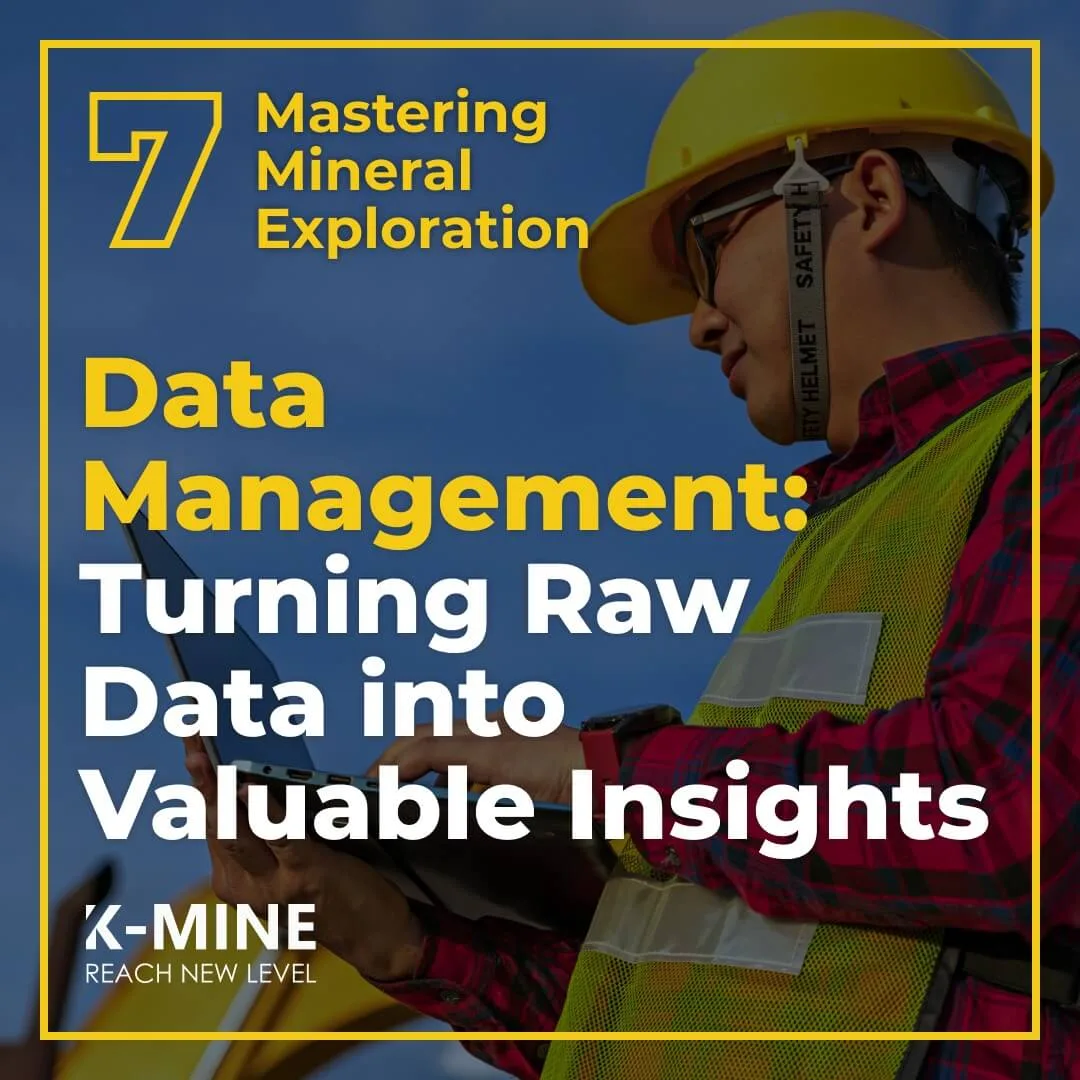
Content
- The Importance of Data in Mineral Exploration
- Types of Data in Mineral Exploration
- Data Management – A Key to Success
- From Data to Knowledge – The Role of Data Analysis
- The Power of Visualization
- Challenges in Data Management and Interpretation
- Future Trends in Exploration Data Management
- Conclusion
Mineral exploration is a complex and intricate process, one that requires both tenacity and precision. However, the key to unlocking a successful mining project is not just the act of drilling into the earth or mapping its geophysical properties, but rather, the ability to turn a plethora of raw exploration data into valuable geological insights. This challenging but critical transition relies on meticulous data management and shrewd interpretation.
After all, understanding what lies beneath our feet isn’t solely about collecting data; it’s about comprehending that data’s narrative and applying it to create a clear and precise picture of potential mining sites. This article aims to delve into the nuts and bolts of how geologists and mining companies turn data into knowledge, powering the mining industry forward.
The Importance of Data in Mineral Exploration
The relentless pursuit of valuable mineral deposits is a venture that does not afford the luxury of ambiguity or uncertainty. In this context, data collected during the exploration process becomes a cornerstone for successful ventures, driving decision-making and, by extension, the feasibility of potential mining operations.
With every core sample drilled, every geophysical survey conducted, and every geochemical analysis performed, we amass a wealth of data. Each data point gathered paints a small part of a much larger picture, representing a snippet of the geological story beneath the surface. When collected, collated, and analyzed correctly, these data points merge to form a coherent narrative.
Investors, stakeholders, and geologists rely heavily on this narrative. A thorough understanding of the geological data can significantly reduce investment risk by providing clearer predictions about the quantity and quality of mineral resources at a site. Moreover, it supports making informed decisions about whether to advance an exploration project into the development and mining stages or to halt a project that is unlikely to yield a profitable return.
In mineral exploration, data does not just signify numbers or measurements—it represents the blueprint of a potential mining project.
Types of Data in Mineral Exploration
To paint a comprehensive and accurate picture of the subsurface, a myriad of data is collected during the mineral exploration process. These data come from various sources and provide different but complementary insights into the geological setting.
First and foremost, we have drill data. Whether from diamond core, reverse circulation, or auger drilling, these drill logs yield tangible pieces of the Earth’s subsurface. They are our window into the depth, providing invaluable information about the rock types, mineral content, and geological structures present beneath the surface.
Next up, we have geochemical data. These data involve the chemical analysis of rock, soil, vegetation, water, and even the air to detect anomalies or patterns indicative of mineralization. Geochemical data can point us towards elements of interest and help us delineate ore bodies.
Closely tied with geochemical data is geophysical data. Through techniques such as seismic, magnetic, gravity, or electromagnetic surveys, we’re able to get an idea of the subsurface’s physical properties. These properties can hint at the presence of different rock types and potentially, valuable mineral deposits.
Lastly, we also utilize remote sensing data in mineral exploration. Satellite imagery, hyperspectral imaging, and LiDAR can all provide essential information about the surface. Such data can reveal features and patterns that might be indicative of underlying mineral deposits.
Each of these data types plays a unique role in the exploration process. When combined, they can provide a robust and comprehensive understanding of a potential mining site, enabling geologists to make informed decisions about where to focus their exploration efforts.
Data Management – A Key to Success
In the realm of mineral exploration, data is as good as gold. But just like how gold needs to be mined, refined, and shaped to truly shine, data needs to be meticulously managed to extract its full value. That’s where data management comes into play. It’s an often-overlooked part of the exploration process, but successful data management is the backbone of any fruitful exploration venture.
Think of data management as the unsung hero that keeps the gears of exploration turning. With potentially terabytes of data streaming in from various sources, it’s critical to have a system in place that ensures the quality, consistency, and accessibility of this information. Poorly managed data can lead to confusion, misinterpretation, and ultimately, costly mistakes.
That’s where data management systems step in. These are specialized software tools designed to handle large volumes of data. They organize, secure, and retrieve exploration data, ensuring that valuable information is readily available when geologists need it.
A robust data management system is like a well-organized library. Each piece of data is cataloged, labeled, and shelved, ready to be pulled out at a moment’s notice. It ensures that data isn’t just dumped into a proverbial black hole, never to be seen again. Instead, it’s systematically stored in a way that’s easy to access and understand.
But beyond just organizing data, these systems also play a critical role in ensuring data security. They implement stringent measures to prevent data loss and unauthorized access, keeping the valuable information secure. After all, in the competitive world of mineral exploration, data is often a company’s most prized asset.
In conclusion, effective data management is crucial for the success of mineral exploration. It not only ensures the quality and accessibility of data but also serves as a protective barrier, keeping valuable information safe and secure. Through proper data management, geologists can work with the assurance that the data they need is always within reach, ready to be transformed into valuable geological insights.
From Data to Knowledge – The Role of Data Analysis
The mineral exploration process is akin to assembling a complex puzzle. The pieces of this puzzle come in the form of diverse datasets – drill logs, geochemical assays, geophysical readings, remote sensing data, and more. Each piece of data on its own may not tell us much, but when integrated and analyzed, they can unravel the geological secrets hidden beneath the Earth’s surface. This is where data analysis steps into the spotlight.
Data analysis is the engine that drives the transformation of raw, seemingly indecipherable data into interpretable information and ultimately actionable knowledge. Without it, the amassed data from exploration would remain as an untapped resource, much like a mineral deposit left unmined.
Different data analysis techniques serve as the tools that allow us to decipher the story that the data tells. Let’s take statistical analysis, for instance. It is fundamental to data interpretation and allows us to spot trends, anomalies, and correlations within our datasets. An anomalous geochemical reading or an unusual geophysical signature can serve as the first clue pointing to a potential mineral deposit.
Geostatistics takes things a step further by introducing a spatial element into our analysis. In mineral exploration, the ‘where’ is just as important as the ‘what.’ Geostatistics helps us understand the spatial relationship between our data points, giving us insights into how mineralization may vary across a deposit.
Then we have the burgeoning field of machine learning, which has made significant inroads into mineral exploration in recent years. Machine learning algorithms can sift through large volumes of data, identifying subtle patterns that might be missed by the human eye. They allow for predictive modeling, which can help anticipate where mineralization is likely to occur, saving valuable time and resources.
In summary, data analysis is the critical process that turns raw data into valuable knowledge. It’s the alchemist’s stone of the mineral exploration world, transforming the lead of raw data into the gold of geological insights. It’s the difference between simply having data and truly understanding it. The advanced data analysis techniques at our disposal today have revolutionized the field of mineral exploration, empowering us to uncover mineral deposits with a level of precision and confidence previously unimaginable.
The Power of Visualization
In the world of mineral exploration, data is the key that unlocks a treasure chest of geological insights. However, to truly harness the power of data, we need more than numbers on a spreadsheet or results from an analysis. We need to ‘see’ the data, to understand its spatial relationships and interactions. That’s where data visualization comes into play.
Data visualization is a process that translates complex data sets into a graphical format, allowing geologists to interpret the information more efficiently and accurately. It’s akin to providing a bird’s-eye view of the entire geological puzzle, revealing patterns, trends, and anomalies that can be hidden in raw data.
Visualizations, such as 3D geological models and maps, give a tangible form to the abstract data. They enable geologists to journey beneath the Earth’s surface, to virtually explore the unseen. For instance, a 3D model can vividly showcase the architecture of a mineral deposit, including its size, shape, orientation, and relationship with surrounding geological structures. This isn’t just useful for geologists; it’s also invaluable when it comes to communicating findings to stakeholders, who may not have the same level of geological expertise.
In this domain, specialized software like K-MINE can be a geologist’s best ally. K-MINE provides a suite of data visualization tools specifically designed for the mining industry. With features allowing for 3D modeling, volume calculations, topographical representation, and many more, K-MINE transforms the daunting task of data visualization into a streamlined, user-friendly process. It makes data not just visible, but also interactive, allowing geologists to manipulate and examine their data from every possible angle.
In essence, data visualization is more than just creating pretty pictures. It’s a means of extracting meaning from the mountain of data generated during mineral exploration. It illuminates the data, casting light on the paths that could lead us to the next big mineral discovery. It is an indispensable tool in the geologist’s kit, shaping the way we understand and interact with our data.
Challenges in Data Management and Interpretation
Navigating the realm of data management and interpretation in mineral exploration isn’t without its challenges. As geologists, we find ourselves dealing with an array of complex issues related to data volume, data quality, and software limitations.
To start with, the sheer volume of data that modern exploration activities generate can be overwhelming. As we deploy increasingly sophisticated tools and techniques, from high-resolution remote sensing to detailed geochemical surveys, the data deluge continues to swell. Managing this vast ocean of data, ensuring that it’s stored securely yet remains accessible for analysis, is no small task.
Then there’s the issue of data quality. Subpar or erroneous data can lead even the most experienced geologist astray. Errors can creep in at any stage of the exploration process, be it due to equipment malfunction, human error, or even natural interference. Therefore, rigorous data quality checks are a necessity, not a luxury. Ensuring the integrity and reliability of our data is an ongoing battle, demanding constant vigilance.
Lastly, we have the challenge of software limitations. While there are numerous software solutions available for data management and analysis in mineral exploration, not all are created equal. Some may lack the capabilities to handle large data sets efficiently, while others might not offer the necessary tools for sophisticated data analysis or visualization. As geologists, we must choose our software with care, assessing its capabilities and limitations in light of our specific needs.
Yet, despite these challenges, it’s clear that the rewards of effective data management and interpretation far outweigh the difficulties. As we continue to refine our methods and innovate with technology, we are continually getting better at turning raw data into valuable geological insights. The challenge is part of the journey, a testament to our quest for knowledge and discovery in the fascinating field of mineral exploration.
Future Trends in Exploration Data Management
The realm of data management and interpretation in mineral exploration, much like other facets of the industry, is being reshaped by the relentless march of technology. As we gaze into the crystal ball, several trends stand out, poised to redefine our relationship with data in the coming years.
Firstly, we have the rise of artificial intelligence (AI) and machine learning. These technologies are becoming increasingly adept at pattern recognition and predictive modeling. In the context of mineral exploration, they can sift through vast volumes of data, identifying patterns and correlations that might escape even the most experienced geologist. The potential here is enormous, from predicting the location of mineral deposits to optimizing exploration strategies based on historical data.
Next, there’s the shift towards cloud-based data storage. As the volume of exploration data continues to grow, the limitations of traditional, on-premise storage solutions become increasingly apparent. Cloud storage offers a scalable, secure, and cost-effective alternative. It allows geologists to access their data from anywhere in the world, fostering collaboration and ensuring that valuable insights aren’t confined to the office.
Last but not least, we have the promise of real-time data processing. With advancements in sensor technology and data transmission, it’s becoming increasingly feasible to analyze exploration data in real-time. This allows geologists to make informed decisions on the fly, adapting their exploration strategy based on immediate feedback from the field.
These trends represent just the tip of the iceberg. As technology continues to evolve, who knows what other possibilities lie in store? But one thing is certain: the future of data management and interpretation in mineral exploration looks bright, filled with exciting opportunities for those willing to embrace the wave of digital transformation.
Conclusion
As we draw this discussion to a close, the critical role of data management and interpretation in mineral exploration stands illuminated. In the highly speculative and risk-ridden endeavor of mineral exploration, data is the geologist’s most trustworthy ally. It helps us separate the wheat from the chaff, guiding us towards promising prospects while steering us clear of potential dead ends.
We’ve seen how varied the types of data collected during mineral exploration can be, each carrying a piece of the geological puzzle waiting to be solved. We’ve stressed the importance of proper data management, an often overlooked aspect that ensures the integrity, accessibility, and security of our precious data. We’ve also discussed how the unrefined raw data, through meticulous analysis and clever visualization techniques, can be molded into valuable insights that drive successful exploration projects.
However, as with any complex task, challenges do exist. From managing the sheer volume and variety of data to ensuring its quality and selecting the right software tools, data management and interpretation isn’t a walk in the park. But the future looks promising. With advancements in AI and machine learning, the emergence of cloud-based storage, and the potential of real-time data processing, we stand at the cusp of a new era in exploration data management.
As we look ahead to the next article in this series, we’ll explore the final frontier in mineral exploration – the decision-making process. We’ll delve into how all the information we’ve collected, analyzed, and interpreted informs the ultimate question: “Is this prospect worth pursuing?” But that, dear reader, is a discussion for another day. Until then, remember: in mineral exploration, data isn’t just king, it’s the whole kingdom.



 Back
Back